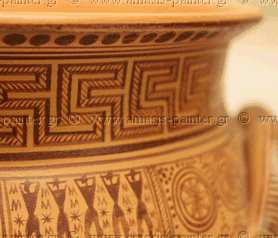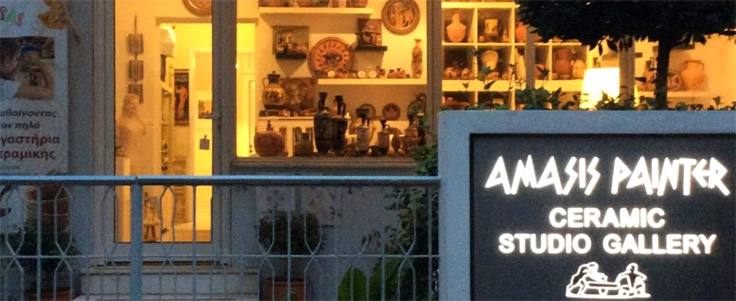Athanasios Katsaras, potter and vase painter
For thousands of years in the land where the Arts were born, the apprentice, on his way to become a master, made mazes, idols, oil jars, Pathenons and statues of Aphrodite.
I was born in 1965, my mother being a potter and my father a vase painter. The ceramic tradition of my family can be traced back in Minor Asia, the land of Aeolia, in the beginning of the previous century.
I studied sociology and physical education. I also attended a computer course in Athens but the Fates in the land of Philokalia (love of the elegance) decided differently. My apprenticeship in pottery and pottery painting, which started in my tender childhood years, seemed much more fascinating.
In the 1990s I live and work in Santorini where I set up Amasis-Ariadne Gallery and Ceramic Studio. At the same time my work is exhibited in other places, as well. I cooperate with galleries abroad and make replicas of frescos from Thira for houses and hotels. In 2014 I represented Greece in Washington, U.S.A., during the European Month of Culture, often organizing open workshops of vase painting and coroplastic art. Presently, I cooperate with museums and educational organizations in the making of replicas and the organization of educational programs.
Even till now, I rejoice at “reading” the different aspects of psyche encoded in ancient Hellenic painting and try to reproduce them.
I am fond of the Cycladic civilization and I revere that artist from Cyclades who depicted the Aegean landscape surrounding him on clay : the sea - with four spiral engravings – the fish and the sun in the middle.
Throughout these years, my main interest has been in acquiring further knowledge about the characteristics, not only of the painting style whose spirit is apparent all over the item, but also of the unique style of each particular artist of the original item, while I treat each item like having a different unique soul.
The entire process of the work is done exclusively by hand. I use either thin brushes for the red-figure and white-ground vases or thin needles to engrave the details for the black-figure ones like Greek painters did in ancient times.
The result of all this is a feeling of excitement and pride that I take in continuing the tradition of an art which appeared in the Mediterranean region thousands of years ago.
|









![]()
